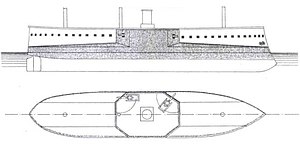Ottoman ironclad Mukaddeme-i Hayir

Line-drawing of the Feth-i Bülend class
|
|
| History | |
|---|---|
|
|
|
| Name: | Mukaddeme-i Hayir |
| Namesake: | "Great Abundance" |
| Ordered: | 1868 |
| Builder: | Imperial Arsenal |
| Laid down: | 1870 |
| Launched: | 28 October 1872 |
| Commissioned: | 1874 |
| Decommissioned: | 1923 |
| Fate: | Broken up, 1923 |
| General characteristics | |
| Class and type: | Feth-i Bülend class |
| Displacement: | 2,762 t (2,718 long tons; 3,045 short tons) |
| Length: | 72 m (236 ft 3 in) (p.p.) |
| Beam: | 11.9 m (39 ft 1 in) |
| Draft: | 5.2 m (17 ft 1 in) |
| Installed power: |
|
| Propulsion: | 1 shaft, horizontal compound steam engine |
| Speed: | 12 knots (22 km/h; 14 mph) |
| Complement: | 16 officers, 153 sailors |
| Armament: | 4 × 229 mm (9 in) Armstrong guns |
| Armor: | |
Mukaddeme-i Hayir (Ottoman Turkish: Great Abundance) was the second of two Feth-i Bülend-class ironclads built for the Ottoman Navy in the 1860s. The Ottoman Navy ordered her from the Imperial Arsenal in Constantinople, and she was laid down in 1870, launched in 1872, and commissioned in 1874. She was armed with four 229 mm (9.0 in) guns, was powered by a single-screw compound steam engine with a top speed of 12 knots (22 km/h; 14 mph). The ship saw action during the Russo-Turkish War of 1877–1878, but was from 1878 to 1897. At the start of the Greco-Turkish War in 1897, the Ottoman Navy mobilized Mukaddeme-I Hayir and the rest of the ironclad fleet but found almost all of the ships to be in unusable condition. Mukaddeme-i Hayir was disarmed the following year and converted into a stationary training ship in 1911. After the outbreak of World War I in 1914, she became a barracks ship, and served in this capacity until 1923, when she was broken up.
Mukaddeme-i Hayir was 72.01 m (236 ft 3 in) long between perpendiculars, with a beam of 11.99 m (39 ft 4 in) and a draft of 5.51 m (18 ft 1 in). The hull was constructed with iron, and displaced 2,762 metric tons (2,718 long tons; 3,045 short tons) normally and 1,601 t (1,576 long tons; 1,765 short tons) BOM. She had a crew of 16 officers and 153 enlisted men.
...
Wikipedia
